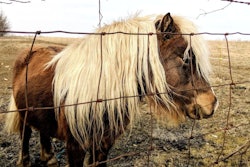
The lab that identified pentobarbital in Evanger’s dog food in 2017 has published details of the procedure researchers used to detect the barbiturate that was correlated to the death of one dog and sickening of others. Michigan State University scientists, led by John P. Buchweitz, developed “simple, yet efficient” method for the extraction and quantitative analysis of pentobarbital in dog food.
The Journal of Agricultural and Food Chemistry published online the pentobarbital detection procedure.
Details of pentobarbital detection method for pet food
No acceptable limit for pentobarbital in pet food exists, so the Michigan State researchers needed a method that could detect even minute quantities of the drug. The recently publish method can detect the drug at 0.6 parts per billion and can reliably quantify the amount found down to 2 parts per billion, a level known as the limit of quantitation. The procedure also has other benefits over previous methods.
“The procedure relies on a combined Food Emergency Response Network (FERN) and QuEChERS (Quick, Easy, Cheap, Effective, Rugged and Safe) approach to sample extraction followed by quantitative analysis by gas chromatography-tandem mass spectrometry (GC/MS/MS) using pentobarbital-d5 as an internal standard,” wrote the researchers in the abstract of their publication. “This procedure improves upon other GC/MS methodologies in that derivatization of pentobarbital or its deuterated internal standard is unnecessary…”
History of pentobarbital in pet food
Horse meat and a deadly drug were found in cans of recalled Evanger’s Hunk of Beef dog food, but how they got there remains a mystery. Evanger’s vice president blamed his meat supplier for allegedly using meat from horses euthanized with pentobarbital. Yet, the United States Food and Drug Administration (FDA) inspected the supplier’s plant and found systems in place to keep euthanized animals out of the food stream, reported Food Safety News. However, FDA officials did note health concerns in Evanger’s facility where the contaminated pet food was made.
“It [pentobarbital] was never on the radar screen,” Evanger’s vice president Joel Sher told Petfood Industry. “It wasn’t an appropriate test in our industry, for what we do, to test for pentobarbital…I might as well start testing for radioactivity at this point. It’s certainly not on the radar screen, but if something ever happened you know someone will say we didn’t check for it.”
One Pug's death was correlated with eating the pentobarbital tainted dog food, and four other dogs were sickened. Pentobarbital, a barbiturate, is used to euthanize animals and as a human sedative and anticonvulsant, as well as in human executions and physician-assisted suicides.
Sher noted that the adulterated pet food didn’t technically kill the Pug.
“The one that didn’t survive was a 13- or 14-year-old Pug that had some health issues,” said Sher. “The decision was made to euthanize the fourth Pug.”
Pentobarbital may be wider pet food ingredient problem
The resurgence of recalls and dog illnesses related to pentobarbital contamination of pet foods startled Steven Solomon, D.V.M., now in his second year as director of the Center for Veterinary Medicine in the U.S. Food and Drug Administration (F.D.A.). The cycle of pentobarbital-related recalls needs to be halted with preventive controls, he said, but noted new evidence suggests that the problem may be more pervasive than originally thought.
“I was surprised earlier this year when pentobarbital came back as an issue, and came back in full force,” he said during the Feed and Pet Food Joint Conference in St. Louis, Missouri, USA. “Pentobarbital simply should not be found in pet food. The American public, especially pet owners, demand this of us as regulators. They deserve to know the comforting fact that their animal's food does not contain a substance that is intentionally used to euthanize animals.”
On March 2, the F.D.A. upgraded J.M. Smucker’s withdrawal of pet food products to a recall affecting Kibbles ‘N Bits, Ol' Roy and Skippy brands. The FDA based this decision on a test confirming the presence of pentobarbital in the tallow ingredient used in the affected products.
Pentobarbital as widespread pet food ingredient supply problem
The problem of pentobarbital entering the companion animal food stream may be more widespread than initially presumed, he said, although the F.D.A. investigation has not concluded.
“Most of us probably think that pentobarbital contamination comes from a few bad actors,” he said. “New evidence is showing it may be a much more pervasive problem in the animal food supply than originally thought.”
Although Solomon said he believes that rendered products may be a source of pentobarbital in pet food ingredients, he also recognized that rendered products are valuable to the pet food industry and reduce strains on the environment.
F.D.A. acts on pentobarbital in pet food
“There's a 14 to 15 year time frame between the last pentobarbital recalls and the start of the most recent recalls,” he said. “This kind of tells a story that some of these issues reoccur, and we need to be diligent as to what hazards can reoccur.”
F.D.A. officials are currently working to address the problem of pentobarbital in pet food, Solomon said. The current draft of “Hazard Analysis and Risk Preventive Controls for Food for Animals” guidance document (GFI #245) now contains advice on dealing with the issue of pentobarbital.
The framework of the Food Safety Modernization Act (F.S.M.A.) allows F.D.A. to establish means to monitor for pentobarbital in the pet food supply chain, he said. Old policies need to be updated to incorporate F.S.M.A. hazard analysis and preventive controls frameworks.
Federal officials are willing to work with pet food makers to implement preventive control for animal feed regulations through education, guidance meetings and discussions to help control pentobarbital in pet food, he said.
"We're well aware that some of you have already taken steps to address this hazard and we appreciate that,” Solomon said.














